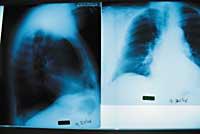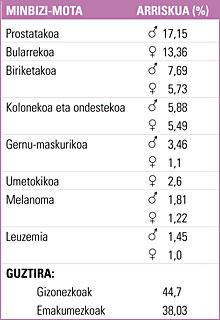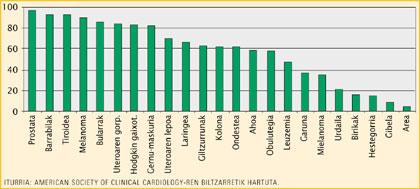New advances in cancer control
Farmazian doktorea. Biofarmazia, Farmakozinetika eta Farmazia-teknologiako irakasle kolaboratzailea
Farmazia Fakultatea UPV-EHU, Vitoria-Gasteiz

Unfortunately, there are still no suitable drugs to cure all types of cancer and, in addition, not all patients respond equally. But, at least, today's medicines have a great specificity, that is, they only kill sick and unhealthy cells. Side effects are less severe.
There are reasons to be optimistic. On the one hand, cancer patients live longer and longer in general. For example, in Spain 50% of those affected by cancer do not die for it, and in France that percentage is even higher. Both are one of the highest in Europe. Likewise, in the last ten years the overall incidence of cancer has decreased by 0.5%, while cancer mortality has decreased by 1.1%.

In addition, treatments for the treatment and cure of certain types of cancer are increasingly effective. For example, for lymphomas, testicular cancer, or breast cancer, 90% of patients do not die from it. All this has been possible thanks to the great advances in prevention and diagnosis, and to increasingly effective and specific treatments.
However, optimism should be moderate, as we should not forget that if it is not detected in time that the success of treatments is greatly reduced and that many people with certain cancers still die. For example, only 10% of patients with lung and area cancer are cured.
Latest data and hope

The 25,000 scientists gathered at the American Society of Clinical Cardiology (ASCO) congress presented interesting results and reported news about hopeful treatments. Among other things, they determined the risk of each sex having one type or another of cancer. For example, prostate cancer is the most common in men, but lung cancer causes the most deaths. In women, however, breast cancer is the most widespread and the one that causes the most deaths.
At the same time, the risk of lung cancer is relatively high, both in men and women, being smokers. According to the latest data, this type of cancer, so harmful, can become the most common in women in the coming years, as more and more young people start smoking.
Knowing the mean life of the patient with each type of cancer is very interesting for both patients and experts. For this reason, the ASCO congress presented an explanatory table of the number of living patients five years after the start of treatment. According to these data, the prognosis of some types of cancer is much better than that of others.

This may be because, on the one hand, the speed and aggressiveness of the disease itself is different in the organs and tissues of the body, and on the other, the diagnoses and treatments present different degrees of progress and effectiveness in each of the subgroups of cancer. However, this table leaves us a positive fact: more than 60% of people with cancer manage to cure the disease.
As for hopeful treatments, clinical trials are testing many new drugs to fight the disease or at least improve the lives and quality of life of patients. For example, in the case of lung cancer, the drug erlotinib is being tested to inhibit some specific types of receptors and thus increase the patient's life. Someone may think that living a few more months is not a big victory, but it is certain that with the type of cancer that kills more patients a step of this type is taken.

Advances in prostate cancer have also been very important. It is the most present cancer and ranks second among the causes of death. Despite its slow evolution, it produces metastases and, after a few years, hormonal treatments are not effective and few survive. With the use of the drug Docetaxel, at least one year of life has been achieved the most serious phases of the disease.
In head and neck cancers the results are even better with cetuximab antibodies. This new drug has significantly reduced the usual side effects and patients can live for 28 to 54 months.
Advances in colon and breast cancer are also noteworthy. On the one hand, scientists have found that drug statins used against cholesterol can have a preventive role in colon cancer. Although they are not yet used for this, according to the latest data, colon cancer decreases by 51% if these drugs are taken.

On the other hand, advances in genetics and biology are taking important steps to avoid the painful effects of breast cancer. For example, recently published in the prestigious journal Cancer Cell, it has managed to inhibit the gene Beta-1-integrin that uses the human body to develop breast cancers. By blocking this gene, researchers have found that cancer loses its ability to develop and that the disease cannot spread.
Final
Cancer is a heterogeneous and complex disease. Many experts believe that under this denomination many diseases are grouped, and well seen, they lack reason. In fact, it is extensible to many tissues and organs and each type of cancer has its own characteristics. Around the world there are thousands of people who channel all their knowledge and efforts against this disease and, although it progresses slowly, they begin to think that we are reaching the end of this disease.






